Growing up, a warm bowl of Korean Squid Soup—Ojingeo Guk—was always on our table when comfort was needed. Whether it was a chilly evening or a quick weekday meal, this light yet deeply flavorful soup brought a sense of calm and satisfaction. With tender squid, soothing broth, and crisp radish, it’s more than just food—it’s a warm hug in a bowl. This recipe brings you that same comfort, using traditional methods and everyday ingredients so anyone can make it at home.
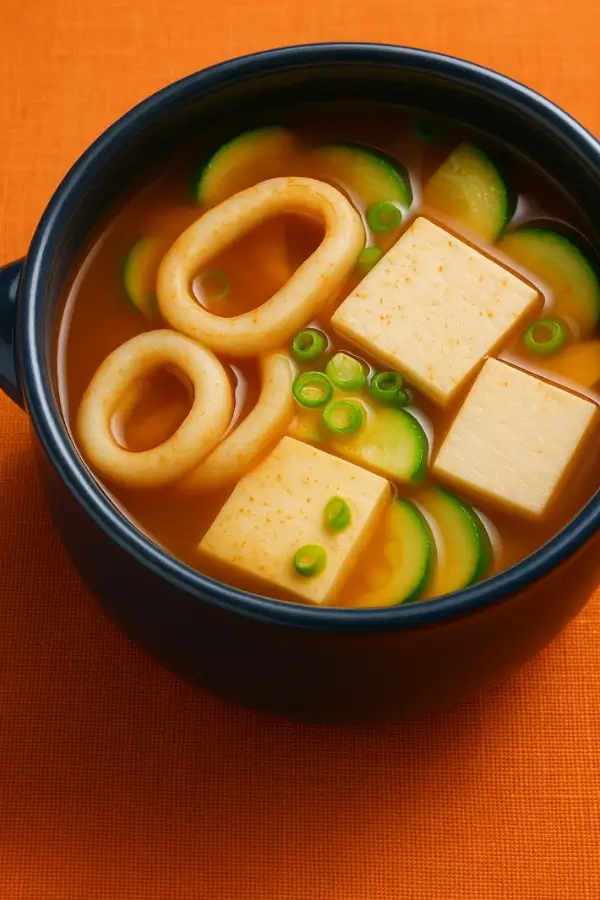
Table of Contents
Why This Ojingeo Guk Recipe Will Become Your New Favorite
- Quick and easy: Ready in under 30 minutes from scratch.
- Authentic Korean flavor with everyday ingredients.
- Perfect for cold days or when you’re feeling under the weather.
- Family-friendly and nourishing without being heavy.
- Balanced and clean taste with just the right kick of spice.
- The squid turns out tender, never rubbery, thanks to the timing trick.
- Unlike some versions, this one offers a clear, savory broth—no overpowering fishiness.
More than just a meal, it’s the kind of soup you’ll crave when you want to feel at home.

Authentic Korean Squid Soup (Ojingeo Guk): Tender Perfection in 30 Minutes
- Total Time: 45 minutes
- Yield: 4 servings 1x
Description
Light, savory, and full of comforting flavor — this Korean squid soup (Ojingeo Guk) is a homestyle favorite. Packed with tender squid and radish in a clean, umami-rich broth.
Ingredients
- 10 g dried kelp (0.4 oz)
- 30 g dried anchovies (1.1 oz), heads & guts removed
- 6 cups water
- 2 small squid (≈ 240 g) cleaned, cut into rings/strips
- 75 g zucchini (1/2 medium), sliced half-moons
- 300 g Korean radish, 1 cm slabs
- 200 g firm tofu (optional), sliced
- 15 g green onion (greens only), thinly sliced
- 1 1/2 Tbsp Korean soup soy sauce (guk-ganjang)
- 1 Tbsp mirin-fu chomiryo
- 1 Tbsp Korean fish sauce
- 1/2 Tbsp minced garlic
- 1/2 Tbsp Korean chili powder (fine)
- 1 tsp Korean chili paste (gochujang)
- 1/8 tsp fine salt, to taste
Instructions
- Combine dried kelp & anchovies with 6 cups water in a medium pot. Bring to a gentle boil, simmer 10 min, remove kelp, simmer anchovies 10 min more, then strain stock.
- Season sliced radish with soup soy sauce; rest 10–15 min.
- Whisk soup seasonings (mirin, fish sauce, garlic, chili powder, gochujang).
- Bring stock to a boil; add seasoned radish & seasonings, then simmer.
- When radish is halfway tender, add squid, zucchini & tofu; simmer until squid is cooked and veggies are tender.
- Taste, adjust salt, garnish with green onion and serve hot with steamed rice.
Notes
Taste the radish first—blanch briefly if bitter.
Slice squid while partially frozen for cleaner cuts.
Prep vegetables while the stock simmers to streamline cooking.
- Prep Time: 10 minutes
- Cook Time: 35 minutes
- Category: Soup
- Method: Simmer
- Cuisine: Korean
Nutrition
- Serving Size: 1 bowl
Essential Ingredients for Your Delicious Korean Squid Soup
For the Rich Korean Soup Stock:
- 10g dried kelp (0.4 oz) – adds umami and depth
- 30g dried anchovies (1.1 oz), heads and guts removed – classic base flavor
- 6 cups water – the foundation for a light, clear broth
Main Fresh Add-ins:
- 2 small squid (approx. 240g / 8.5 oz), cleaned and sliced into bite-sized rings or strips – fresh or thawed from frozen
- 75g zucchini (about 1/2 a medium zucchini), sliced into elegant half-moons – optional but adds subtle sweetness
- 300g Korean radish (10.6 oz), sliced into 1cm (3/8 inch) slabs – essential for a crisp texture and clean flavor
- 200g firm tofu (7 oz), optional – for added protein and creaminess
- 15g green onion (0.5 oz), green part only, thinly sliced – finish with freshness
Signature Korean Soup Seasonings:
- 1 1/2 Tbsp Korean soup soy sauce (guk-ganjang) – saltier and more savory than regular soy sauce
- 1 Tbsp mirin-fu chomiryo – subtly sweet cooking rice seasoning
- 1 Tbsp Korean fish sauce – deepens the umami profile
- 1/2 Tbsp freshly minced garlic – for bold aroma
- 1/2 Tbsp Korean chili powder (gochugaru), finely ground – optional heat and color
- 1 tsp Korean chili paste (gochujang) – optional for deeper flavor
- 1/8 tsp fine salt, or to taste – adjust as needed at the end
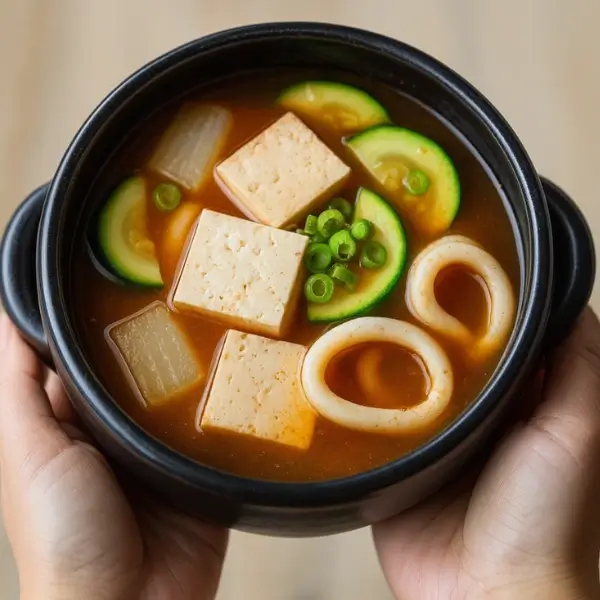
Step-by-Step: Crafting Your Authentic Korean Squid Soup (Ojingeo Guk)
1. Build the Broth
- In a medium pot, combine dried kelp and dried anchovies with 6 cups of water.
- Bring to a gentle boil over medium heat.
- After 5 minutes, remove the kelp to prevent bitterness.
- Continue simmering the anchovies for another 10 minutes to fully extract flavor.
- Strain the broth through a fine mesh sieve and discard the solids.

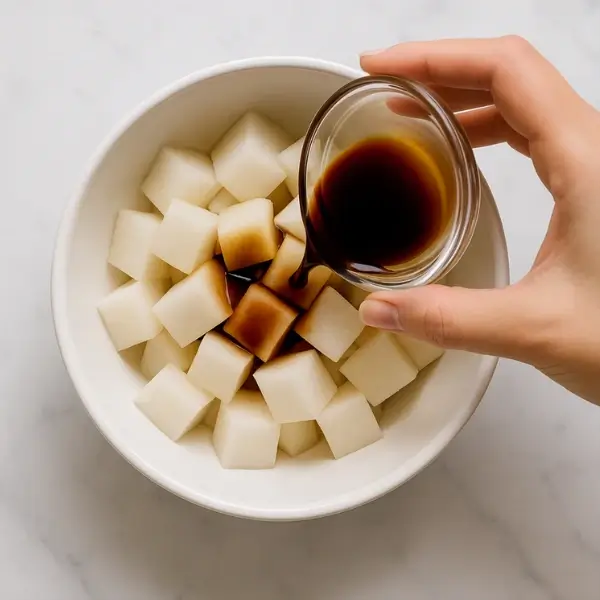
2. Prep and Marinate the Radish
- Place the sliced radish in a bowl and mix with the Korean soup soy sauce.
- Let it sit for 10–15 minutes. This step helps the radish soak up flavor early.

3. Mix Seasonings
- In a small bowl, combine mirin, fish sauce, minced garlic, chili powder, chili paste, and salt.
- Keep this mixture nearby—it’ll be added all at once later.
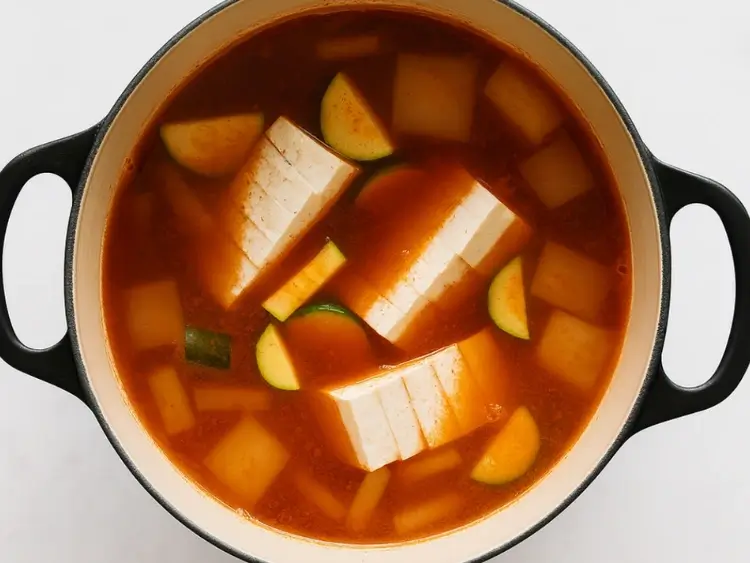
4. Simmer the Soup
- Return the strained broth to the stove and bring it back to a boil.
- Add the marinated radish and seasoning mix.
- Reduce heat to medium and simmer gently for about 8–10 minutes, allowing the flavors to meld.
5. Add the Main Ingredients
- Once the radish is nearly tender, stir in the squid, zucchini, and tofu (if using).
- Cook for 2–3 minutes, just until the squid turns opaque and the zucchini is tender. Avoid overcooking the squid—it should stay soft.
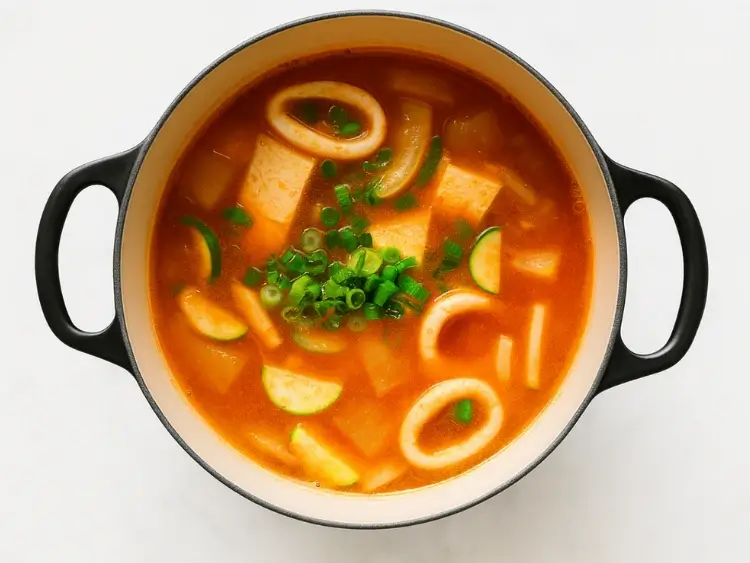
6. Finish and Serve
- Taste the soup and adjust seasoning with a pinch more salt if needed.
- Just before serving, sprinkle the chopped green onion on top.
- Serve hot, ideally with a bowl of steamed white rice and a few Korean side dishes.
Serving Suggestions & Smart Storage Tips
Serving Ideas:
- Pour the hot soup into deep bowls and serve immediately with plain white rice on the side.
- This dish pairs beautifully with Korean side plates like kimchi, seasoned bean sprouts, or pickled vegetables.
- For spice lovers, set extra chili flakes or a touch of gochujang on the table to let each person adjust the heat to their liking.
Storing Your Soup:
- Allow the soup to cool before transferring it to a sealed container.
- Store in the refrigerator and enjoy within 3 days for best flavor and texture.
- The broth tends to taste richer after resting, making leftovers extra enjoyable.
Warming Up Leftovers:
- Reheat slowly on the stove using low to medium heat—no need to boil again.
- Be gentle when stirring, especially if tofu is included, to keep everything intact.
- If the broth seems too concentrated after chilling, add a little water to bring back its original consistency.
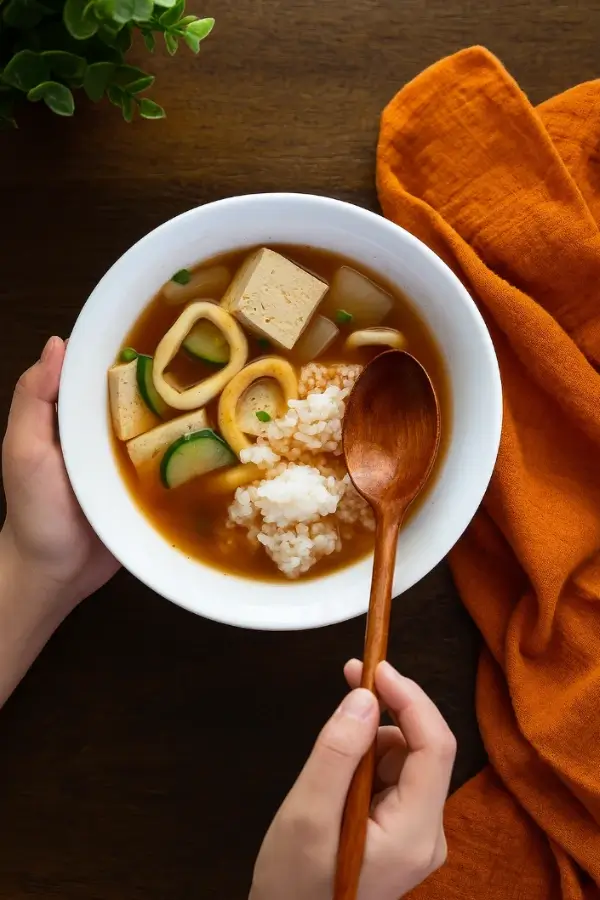
Expert Notes & Recipe Variations
Smart Cooking Tips:
- Keep squid tender: Add it toward the end and cook briefly—just until it changes color.
- Check your radish: If it tastes sharp or too peppery, soak it in cold water for about 10 minutes before using.
- Clear broth trick: Use a spoon to remove any foam as the broth simmers. This helps it stay bright and clean-looking.
Ingredient Options:
- No Korean radish? Daikon is a solid replacement. It’s mild and holds up well in soups.
- No soup soy sauce? Use regular soy sauce sparingly. It’s stronger, so go easy to avoid overpowering the broth.
- Using frozen squid? Make sure it’s fully thawed and rinsed to remove any fishy scent before slicing.
Taste Tweaks:
- Prefer a mellow soup? Leave out the chili powder and paste for a cleaner broth.
- Want extra depth? Add a drop or two of toasted sesame oil just before serving.
- Need more umami? Simmer a slice of onion or a few extra anchovies with the stock.
Try These Twists:
- Seafood lovers: Toss in shrimp or clams for more variety.
- Plant-based version: Use tofu and a mushroom-kelp broth instead of seafood.
- Veggie boost: Add sliced mushrooms, carrots, or spinach near the end for extra color and nutrition.
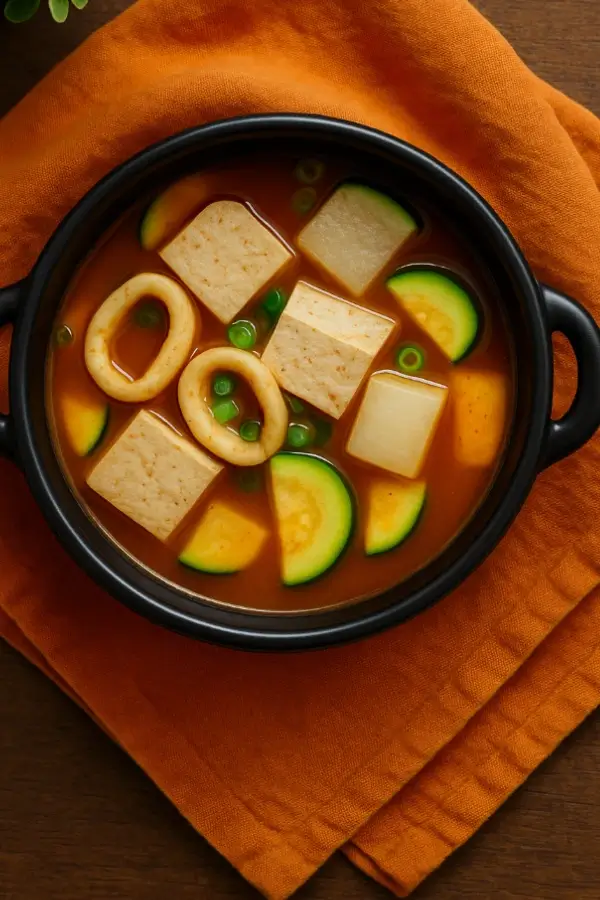
Frequently Asked Questions
What is Ojingeo Guk?
Ojingeo Guk is a traditional Korean soup made with squid, radish, and a light, savory broth. It's known for its clean flavor and comforting warmth, often enjoyed as a home-cooked meal.
What are the main ingredients in Korean Squid Soup?
The core ingredients include squid, Korean radish, soup soy sauce (guk-ganjang), anchovy-kelp broth, garlic, and optional additions like tofu, zucchini, and chili flakes.
How is the Korean Soup Stock made for Ojingeo Guk?
It's made by simmering dried anchovies and kelp in water. This base creates a mild, umami-rich broth that’s essential for many Korean soups.
What is the purpose of marinating the radish in Ojingeo Guk?
Marinating the radish in soup soy sauce before cooking helps it absorb seasoning early, giving each piece a deeper flavor once added to the broth.
Can I use frozen squid for Korean Squid Soup?
Yes. Just thaw it completely and rinse well before slicing. Frozen squid is a great alternative when fresh isn’t available.
What are some tips for making Ojingeo Guk?
Don’t overcook the squid, skim the broth for clarity, and taste your radish before cooking. Simple details like these keep the soup tasting fresh and balanced.
What dishes are commonly served with Ojingeo Guk?
It’s typically served with steamed rice and classic Korean sides like kimchi, seasoned bean sprouts, or pickled vegetables.
Is there a specific occasion for eating Ojingeo Guk?
Though often enjoyed as an everyday meal, it's especially comforting on cold days or when you're feeling under the weather.
Conclusion
If you’re craving something bold, fresh, and satisfying, Bibim Mandu (Korean Potsticker Salad) checks every box. It brings together crispy dumplings, crunchy vegetables, and a punchy sauce that’s hard to forget. Whether you’re serving it as a quick lunch, party appetizer, or just treating yourself, this dish delivers big flavor with simple steps.
Tried this Bibim Mandu recipe? Leave a comment below and rate it with stars—your feedback means a lot. And if you made your own twist, we’d love to hear about it!
Don’t forget to share your plate on social media—tag your photos on Pinterest or Facebook so others can see your take on this Korean favorite.
Love Easy, Flavor-Packed Recipes
If you’re enjoying this recipe and want more quick, delicious meals like it, follow us on Facebook and Pinterest for new posts, cooking tips, and behind-the-scenes peeks from my Brooklyn kitchen. We share weekly ideas to make your time in the kitchen easier—and more fun.



